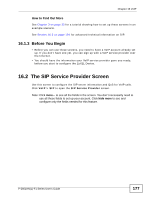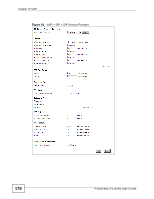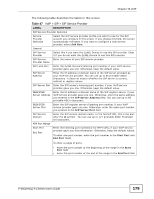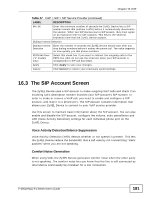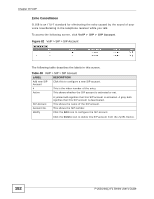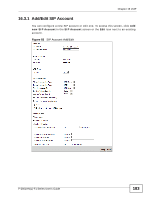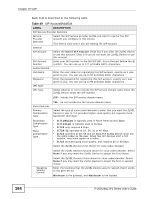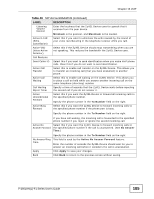ZyXEL P-2601HN-F1 User Guide - Page 180
VoIP > SIP > SIP Service Provider continued
 |
View all ZyXEL P-2601HN-F1 manuals
Add to My Manuals
Save this manual to your list of manuals |
Page 180 highlights
Chapter 16 VoIP Table 47 VoIP > SIP > SIP Service Provider (continued) LABEL DTMF Mode DESCRIPTION Control how the ZyXEL Device handles the tones that your telephone makes when you push its buttons. You should use the same mode your VoIP service provider uses. RFC2833 - send the DTMF tones in RTP packets. PCM - send the DTMF tones in the voice data stream. This method works best when you are using a codec that does not use compression (like G.711). Codecs that use compression (like G.729 and G.726) can distort the tones. SIP INFO - send the DTMF tones in SIP messages. Transport Type Transport Type Select the transport layer protocol (UDP or TCP) used for SIP. FAX Option This field controls how the ZyXEL Device handles fax messages. G711 Fax Passthrough Select this if the ZyXEL Device should use G.711 to send fax messages. The peer devices must also use G.711. T38 Fax Relay Select this if the ZyXEL Device should send fax messages as UDP or TCP/IP packets through IP networks. This provides better quality, but it may have inter-operability problems. The peer devices must also use T.38. Outbound Proxy Enable Select this if your VoIP service provider has a SIP outbound server to handle voice calls. This allows the ZyXEL Device to work with any type of NAT router and eliminates the need for STUN or a SIP ALG. Turn off any SIP ALG on a NAT router in front of the ZyXEL Device to keep it from re-translating the IP address (since this is already handled by the outbound proxy server). Server Address Enter the IP address or domain name of the SIP outbound proxy server. Server Port Enter the SIP outbound proxy server's listening port, if your VoIP service provider gave you one. Otherwise, keep the default value. QoS Tag SIP TOS Priority Enter the DSCP (DiffServ Code Point) number for SIP message Setting transmissions. The ZyXEL Device creates Class of Service (CoS) priority tags with this number to SIP traffic that it transmits. RTP TOS Priority Setting Enter the DSCP (DiffServ Code Point) number for RTP voice transmissions. The ZyXEL Device creates Class of Service (CoS) priority tags with this number to RTP traffic that it transmits. Timer Setting Expiration Duration Enter the number of seconds your SIP account is registered with the SIP register server before it is deleted. The ZyXEL Device automatically tries to re-register your SIP account when one-half of this time has passed. (The SIP register server might have a different expiration.) Register Resend timer Enter the number of seconds the ZyXEL Device waits before it tries again to register the SIP account, if the first try failed or if there is no response. Session Expires Enter the number of seconds the ZyXEL Device lets a SIP session remain idle (without traffic) before it automatically disconnects the session. 180 P-2601HN(L)-F1 Series User's Guide





